
Do you know how to load a dishwasher? (iStock)
If you’ve ever opened your machine only to find bits of stubborn food still stuck to your plates, chances are you’ve been loading your dishwasher all wrong.
A team of researchers at the University of Birmingham in the U.K. have concluded there is a science to packing dishes into your washer after tracking water movement inside empty and fully loaded machines using radioactive isotopes, reports the Daily Mail.
While each machine is different, the engineers discovered that the water stream was most powerful close to jets on the rotating arms, while areas closer to the walls get more detergent.
“The distribution of water inside a commercial dishwasher is very chaotic,” Dr. Raul Pérez-Mohedano, who led the study at the university’s department of engineering, told the Daily Mail.“Areas with a direct impact from the water jets are very localized and these are only able to cover a very small area of all the crockery surface present.”
The findings from the study indicate that certain dishes—depending on what they have been used for and how dirty they are- should be placed at different areas of the machine for maximum cleaning effectiveness. This relates to the chemical compound of foods and how they respond to different forms of cleaning.
The diagram indicates how best to load your dishwasher for maximum cleaning effectiveness.
Dishes dirtied with carbohydrate foods, such as potatoes or fruits, which can be cleaned with mechanical action and do not require as much soap, should be placed in a circular pattern that mirrors the rotating arms to take advantage of the full water force. But dishes that have been used for chemically sticky proteins, like eggs or meat, should be placed around the edges of the dishwasher to get more soap and soak in the detergent.
“Current commercial dishwashers also show a problem of symmetry - while the ejection of water is produced in a circular movement, the distribution of the crockery follows a rectangular pattern,” said Dr. Pérez-Mohedano. “This automatically produces areas where the impact of water is going to occur for longer.”
Overloading a machine prevents water from reaching all dishes and you are more likely to find gunk plastered onto your plates. So just putting a dish or glass in the machine isn’t a guarantee that it will emerge crystal clean.
Take an inside look at the dishwasher action captured by a GoPro.
